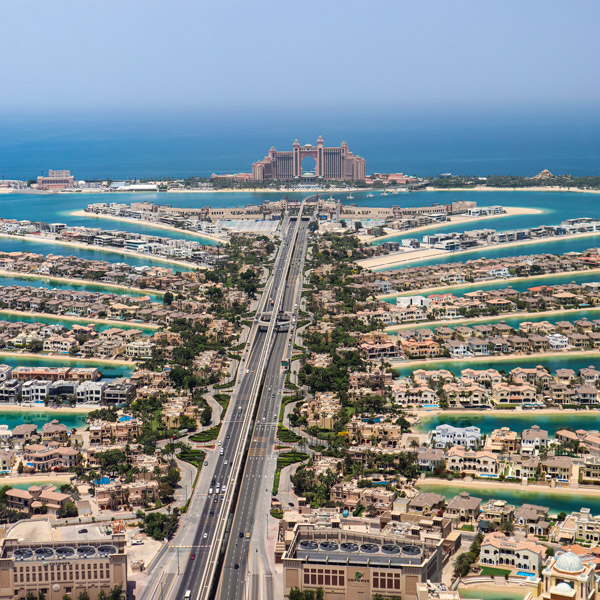Palm Jumeirah
Discover The View at The Palm, a 240-meter-high observation deck on the 52nd floor of the iconic Palm Tower. Offering 360-degree panoramas of Palm Jumeirah, the Arabian Gulf, and Dubai's skyline, this outdoor terrace and premium lounge provides a unique vantage point to see the city's landmarks. With fast-track tickets, bypass the queues and dive straight into the spectacular views. For an even higher perspective, visit the 54th floor for an elevated experience.
Opening hours: 10:00 - 20:00 See all
Things to know
The construction of Palm Jumeirah cost approximately $12 billion. It began in 2001, and the first phase was completed by 2006. Development and expansion continued over the years.
Living in Palm Jumeirah varies widely depending on the type of property. Apartments can start at around AED 1.2 million ($326,700), while villas can range from AED 5 million ($1.36 million) to over AED 100 million ($27.2 million) for ultra-luxury homes.
Dubai built Palm Jumeirah to surprise the world and cement its reputation as the most incredible city. It's all about boosting tourism and creating an unbeatable spot for living, shopping, and entertainment, showcasing Dubai's ambition and innovative spirit.
Palm Jumeirah is home to over 10 hotels and resorts, including renowned names like LINK_PLACEHOLDER_Atlantis The Palm, Waldorf Astoria, and Hilton, offering a wide range of luxury accommodations and amenities. Atlantis The Palm
Palm Jumeirah attracts many celebrities, including footballer LINK_PLACEHOLDER_David Beckham, Bollywood superstar Shahrukh Khan, and singer Madonna. David Beckham
Hotels
Staying at Palm Jumeirah offers a luxurious and unique experience in Dubai. With breathtaking views of the Dubai skyline, the Arabian Gulf, and incredible sunsets, you can choose from high-end resorts or sophisticated apartments, allowing you to experience Dubai's opulence. Based on tourist reviews, here are the top seven hotels by value for money
| Rank | Hotel | Value for money |
|---|---|---|
| 1 | Cheval Maison | 9.3 |
| 2 | Hilton | 8.7 |
| 3 | Marriott Resort | 8.5 |
| 4 | Royal Central | 8.4 |
| 5 | Andaz Residence by Hyatt | 8.3 |
| 6 | Atlantis | 8.3 |
| 7 | Sofitel Resort & Spa | 8.1 |
Impressive Facts
- Palm Jumeirah was built using seven million tons of rock from the Hajar Mountains and 120 million cubic meters of rock and sand dredged from the sea. The materials could form a 2-meter-wide wall circling the globe three times.
- An 11 km (6.8 miles) crescent-shaped breakwater protects the island from strong sea currents and seasonal winds. It includes a geotextile membrane and multiple rock layers, with 100-meter-wide openings on each side to prevent water stagnation.
- Engineers used satellites and high-tech GPS to plot the shape of the island, creating a perfectly palm-shaped structure. The Palm Jumeirah is as large as 600 football pitches and four times the size of London's Hyde Park.
- A temporary dam was built using 200,000 cubic meters of reinforced concrete, 30,000 tons of reinforcing steel, and 110,000 tons of rock. It allowed the construction of a 6-lane sea tunnel 25 meters below sea level, requiring the pumping out of 5.5 million cubic meters of seawater in 45 days.
- Construction began in 2001, and the first residents moved in by 2006. The entire project cost $12 billion. The development includes 1,500 beachfront mansions and 6,000 apartments, with significant hotels like Atlantis The Palm, Waldorf Astoria, and the upcoming St. Regis Dubai in The Palm Tower.
- Palm Jumeirah features a 5.4-kilometer (3.4 miles) monorail, the first in the Middle East, connecting the Atlantis Hotel to the Gateway Towers. The monorail started operating in 2009 and transports over 20,000 passengers daily.
- Palm Jumeirah has a population of over 25,550 residents as of 2022. Initially planned for 4,500 residential units, the number was increased to meet construction costs, leading to a higher housing density and more closely spaced properties.
- The construction of Palm Jumeirah affected the local environment by increasing water-soluble materials and altering water temperatures around the island. To combat water stagnation, the outer breakwater was modified with openings to allow tidal movement and oxygenation.
- Palm Jumeirah is one of the few man-made structures visible from space, highlighting its immense size and unique design.
- During the early months of the COVID-19 pandemic, a reduction in human activity around Palm Jumeirah led to an increase in local wildlife, including dolphins, frequenting the island's waters.
How to get
Address
Palm Monorail
Taxi/Uber
Drop-off: Nakheel Mall